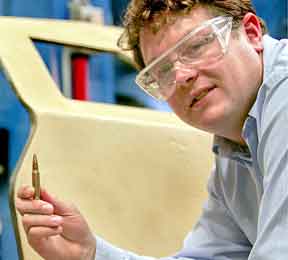While titanium sports the highest strength-to-weight ratio of any metal, it has always been too expensive for all but the most specialised applications.
That could soon change, however, with a new process that has been developed by Oak Ridge National Laboratory and its industry partners.
The new processing technique could reduce the amount of energy required, and hence the cost to make, titanium parts from powders by up to 50 percent, making it feasible to use titanium alloys for brake rotors, artificial joint replacements and armour for military vehicles.
ORNL has already used the process to make a new low-cost titanium alloy door for the Joint Light Tactical Vehicle, a next generation combat vehicle. 'By using a titanium alloy for the door, BAE Systems was able to reduce the weight of its vehicle yet at the same time decrease the threat of armour-piercing rounds,' said Bill Peter, a researcher in ORNL's Materials Science and Technology Division.
The lightweight titanium alloy also improves the operation of the door and increases mobility of the vehicle, making it even more useful to the military.
Peter noted that the so-called non-melt approach used to produce the door offers many advantages over traditional melt processing.
'Instead of using conventional melt processing to produce products from titanium powder, in the new method the powders remain in their solid form during the entire procedure,' Peter said. 'This saves a tremendous amount of energy required for processing, greatly reduces the amount of scrap and allows for new alloys and engineered composites.'

Next-generation combat vehicles equipped with titanium alloy doors will provide increased safety for soldiers. The doors are made using low-cost titanium powders and a non-melt consolidation process developed by a team of Oak Ridge National Laboratory researchers that includes Bill Peter of the Materials Science and Technology Division
While powder metallurgy has been used to produce components for many years, titanium products have not widely been fabricated using these methods because of the high cost of the conventional titanium powders. Now, however, new low-cost titanium powders are enabling ORNL, International Titanium Powders, Ametek and BAE Systems to develop similar processing technologies for titanium.
In coming years, researchers expect lightweight corrosion-resistant titanium alloys to make their way into many other products, including automobiles.




April 1886: the Brunkebergs tunnel
First ever example of a ground source heat pump?